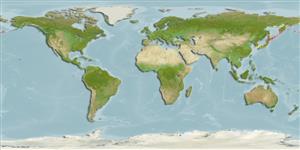Classification / Names
आम नाम | उपशब्द | Catalog of Fishes(वर्ग, प्रजाति) | ITIS | CoL | WoRMS | Cloffa
Issue
Neozoarces steindachneri may be a synonym of Neozoarces pulcher (Ref. 51666).
Environment: milieu / climate zone / depth range / distribution range
पारिस्थितिकी
समुद्री ड़िमरसल; गहराई सीमा 0 - 10 m (Ref. 56557). Temperate
Northwest Pacific: Okhotsk Sea off Sakhalin and Hokkaido, Pacific coast of Hokkaido, Japan Sea off Russian coast from Tatar Strait to Peter the Great Bay and off Japan northward from Aomori Prefecture.
आकार / वज़न / Age
Maturity: Lm ? range ? - ? cm
Max length : 11.0 cm TL पुल्लिंग / अलिंग; (Ref. 56527)
Inhabits seaweed areas along the coast.
Life cycle and mating behavior
Maturities | पुनरुत्पत्ति | Spawnings | Egg(s) | Fecundities | लार्वा
Masuda, H., K. Amaoka, C. Araga, T. Uyeno and T. Yoshino, 1984. The fishes of the Japanese Archipelago. Vol. 1. Tokai University Press, Tokyo, Japan. 437 p. (text). (Ref. 559)
IUCN Red List Status (Ref. 130435)
Threat to humans
Harmless
Human uses
साधन
Special reports
Download XML
इंटरनेट स्रोत
Estimates based on models
Preferred temperature (Ref.
123201): 3.8 - 17, mean 6.2 °C (based on 302 cells).
Phylogenetic diversity index (Ref.
82804): PD
50 = 0.7500 [Uniqueness, from 0.5 = low to 2.0 = high].
Bayesian length-weight: a=0.00389 (0.00180 - 0.00842), b=3.12 (2.94 - 3.30), in cm total length, based on all LWR estimates for this body shape (Ref.
93245).
Trophic level (Ref.
69278): 3.2 ±0.5 se; based on size and trophs of closest relatives
Fishing Vulnerability (Ref.
59153): Low vulnerability (10 of 100).
